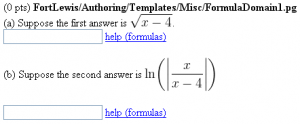Difference between revisions of "FormulaDomain1"
Paultpearson (talk | contribs) |
Paultpearson (talk | contribs) (Add link to PGML version in OPL) |
||
| Line 6: | Line 6: | ||
</p> |
</p> |
||
* File location in OPL: [https://github.com/openwebwork/webwork-open-problem-library/blob/master/OpenProblemLibrary/FortLewis/Authoring/Templates/Misc/FormulaDomain1.pg FortLewis/Authoring/Templates/Misc/FormulaDomain1.pg] |
* File location in OPL: [https://github.com/openwebwork/webwork-open-problem-library/blob/master/OpenProblemLibrary/FortLewis/Authoring/Templates/Misc/FormulaDomain1.pg FortLewis/Authoring/Templates/Misc/FormulaDomain1.pg] |
||
| + | * PGML location in OPL: [https://github.com/openwebwork/webwork-open-problem-library/blob/master/OpenProblemLibrary/FortLewis/Authoring/Templates/Misc/FormulaDomain1_PGML.pg FortLewis/Authoring/Templates/Misc/FormulaDomain1_PGML.pg] |
||
<br clear="all" /> |
<br clear="all" /> |
||
Revision as of 21:19, 7 June 2015
Answer is a Function with Domain Issues
This PG code shows how to set the domain and test points for a formula.
- File location in OPL: FortLewis/Authoring/Templates/Misc/FormulaDomain1.pg
- PGML location in OPL: FortLewis/Authoring/Templates/Misc/FormulaDomain1_PGML.pg
| PG problem file | Explanation |
|---|---|
|
Problem tagging: |
|
DOCUMENT(); loadMacros( "PGstandard.pl", "MathObjects.pl", "AnswerFormatHelp.pl", "answerHints.pl", ); TEXT(beginproblem()); |
Initialization:
We load |
Context("Numeric");
$a = random(2,5,1);
$answer1 = Compute("sqrt(x-$a)");
$answer1->{limits} = [$a+1,$a+4];
$answer2 = Compute("ln(abs( x / (x-$a) ))");
$answer2->{test_points} = [[-5],[-4],[1],[$a-1],[7],[8]];
|
Setup:
We restrict the domain of function evaluation using
The domain for It is possible to set the domain once for all of the functions within a particular context. For more details, please see formula test points in the index of problem techniques. |
Context()->texStrings;
BEGIN_TEXT
(a) Suppose the first answer is
\( \displaystyle $answer1 \).
$BR
\{ ans_rule(20) \}
\{ AnswerFormatHelp("formulas") \}
$BR
$BR
(b) Suppose the second answer is
\( \displaystyle $answer2 \)
$BR
\{ ans_rule(20) \}
\{ AnswerFormatHelp("formulas") \}
END_TEXT
Context()->normalStrings;
|
Main Text: Notice that in this multipart question we have grouped the text for each part together in a block, put each answer blank on a new line immediately below each block of text, and added extra space between each part. This should make the question easy to read both in HTML and PDF format. |
$showPartialCorrectAnswers = 1;
ANS( $answer1->cmp() );
ANS( $answer2->cmp()
->withPostFilter(AnswerHints(
[Compute("ln(x/(x-$a))"),Compute("ln(x)-ln(x-$a)")] =>
"Don't forget to use absolute value",
))
);
|
Answer Evaluation:
It is possible to get diagnostic information about the answer checker using
For the second answer, we have used |
Context()->texStrings;
BEGIN_SOLUTION
${PAR}SOLUTION:${PAR}
Solution explanation goes here.
END_SOLUTION
Context()->normalStrings;
COMMENT('MathObject version.');
ENDDOCUMENT();
|
Solution: |
